How did companies sell 'unmentionable' sanitary towels?
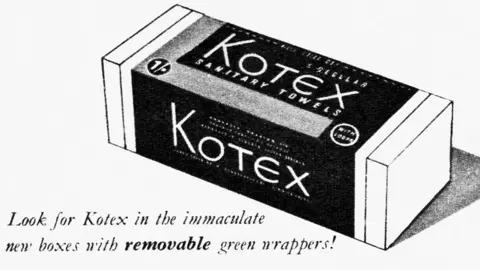 Alamy
Alamy"I wish someone would tell me what Kotex is." So said a bemused young American man at a dinner party in the 1920s. Nobody would, of course. Kotex was a code word - an arcane reference to something meant to be a secret.
Kotex was - and remains - one of the US's most popular brands of menstrual pad.
But, as Sharra Vostral writes in her book Under Wraps, one of the defining missions of menstrual products such as pads, tampons and cups is discretion: the rest of the world simply isn't supposed to know whether a woman is menstruating or not.
And women have had good reason to keep it quiet.
In 1868, the vice-president of the American Medical Association warned female physicians could not be trusted during their monthly "infirmity".
Five years later, the American doctor and sex educator Edward Clarke said girls should be removed from the classroom during their periods. It was too demanding to expect them to think and menstruate at the same time.
The writer Eliza Duffey sharply responded Dr Clarke had no objection to women performing strenuous housework during their periods. Perhaps he just wanted to deny education to girls? Perhaps indeed.
It was hardly surprising women preferred to keep the details of their monthly cycle to themselves, taking a homemade approach.


50 Things That Made the Modern Economy highlights the inventions, ideas and innovations that helped create the economic world.
It is broadcast on the BBC World Service. You can find more information about the programme's sources and listen to all the episodes online or subscribe to the programme podcast.

Tampons have existed for thousands of years: thought to have been made from wool in Rome, vegetable fibres in Indonesia, paper in Japan, grass in Africa, papyrus reeds in Egypt and ferns in Hawaii. Historically, women would also fashion pads from scraps of fabric, often washing and reusing them.
But in the late 19th Century, homemade products were replaced by manufactured commodities in other parts of life, so why not in this case?
The challenge was: how to advertise and sell a product society considered unmentionable?
In fact, the first recorded attempts to sell disposable pads date to the 1890s.
Johnson & Johnson made and marketed "Lister's Towels" in the US in 1896 and "Hygienic Towelettes", from the German manufacturer Hartmann, were advertised in Harrods, in London, in 1895.
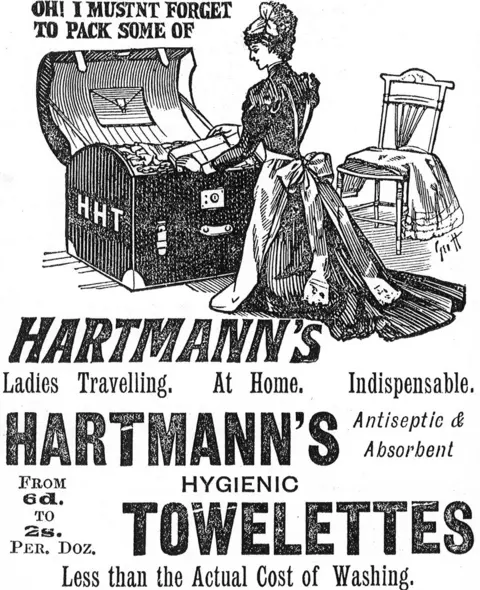 The Advertising Archives
The Advertising ArchivesBut these products didn't make much impact. It seems most women still found it cheaper, or more comfortable, or less embarrassing, to make their own sanitary towels from whatever material they had to hand.
A key technological breakthrough came during World War One, when the paper company Kimberly-Clark used a new material called "cellucotton" to make bandages.
Cellucotton was made of wood pulp. It was much cheaper than cotton and far more absorbent.
At the end of the war, as Kimberly-Clark was looking for new markets, it received letters from nurses saying they were using the cellucotton for something other than bandages.
Clearly, there was a business opportunity. But it seemed risky: didn't Johnson & Johnson's experience suggest the product might be too taboo to succeed?
Kimberly-Clark launched anyway, settling on the mysterious name "Kotex". It stands for "cotton texture" but, more importantly, young men at dinner parties had no idea what "Kotex" meant.
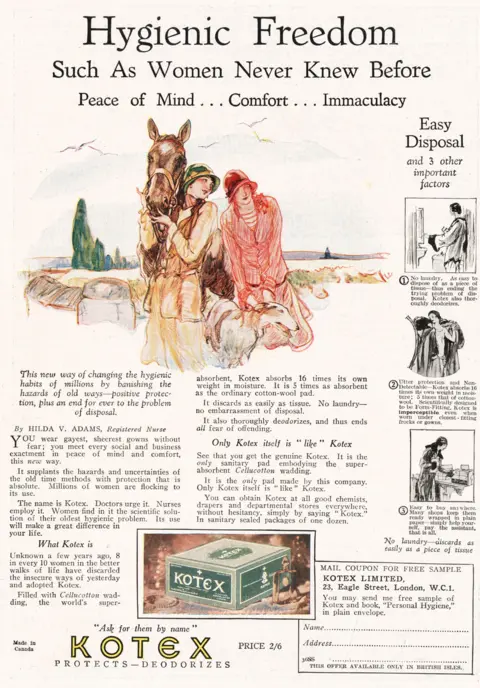 Alamy
Alamy
The new product caught on fast. For decades, women had been finding some independence by taking jobs in factories and offices.
Despite Dr Edward Clark's concerns, they could think and menstruate at the same time, and they needed a convenient, disposable product. To everyone's surprise, Kimberly-Clark had a hit.

More things that made the modern economy:

The first detailed study of the growing menstrual technology market was conducted in 1927, by Lillian Gilbreth, a pioneer in applying scientific ideas from psychology and engineering to commercial problems of marketing, ergonomics and design.
She noted modern women needed to be out and about. She emphasised women wanted a discreetly packaged product.
But while the products themselves were made to be used covertly, soon there was nothing secretive about the way they were marketed. The booming market encouraged manufacturers to bombard consumers with advertisements, albeit euphemistic ones.
Some men may have been mystified in the 1920s; by the 1930s, some felt under siege.
The future Nobel literature laureate William Faulkner complained: "I seem to be so out of touch with the 'Kotex age' here, that I can't seem to think of anything myself."
It takes some nerve to blame Kotex adverts for your writer's block but it says something about how quickly the previously unutterable technology had entered the cultural mainstream.
The cellucotton pad was followed, in the 1930s, by the commercial tampon, patented in 1933 and marketed as "Tampax".
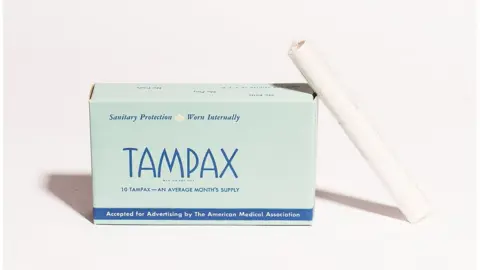 Getty Images
Getty ImagesThe first menstrual cup appeared soon afterwards, in 1937, patented by a woman, Leona Watson Chalmers.
Then came the War. Menstrual products were marketed as a way to help women participate in the war effort. One Kotex ad showed a teenager moping, her broom and mop abandoned.
"Who would have thought you'd turn out to be a deserter from a dust mop and a few dishes, when Mom's counting on you?"
These days, one estimate suggests women spend about $3bn (£2.3bn) a year on sanitary products in the US alone. They have long since entered the culture.
From a Western perspective, the old sense of embarrassment is laughable - 21st Century adverts have mocked the tropes of an earlier age, of blue liquids in sterile laboratories interspersed with shots of women in tight white shorts riding white horses.
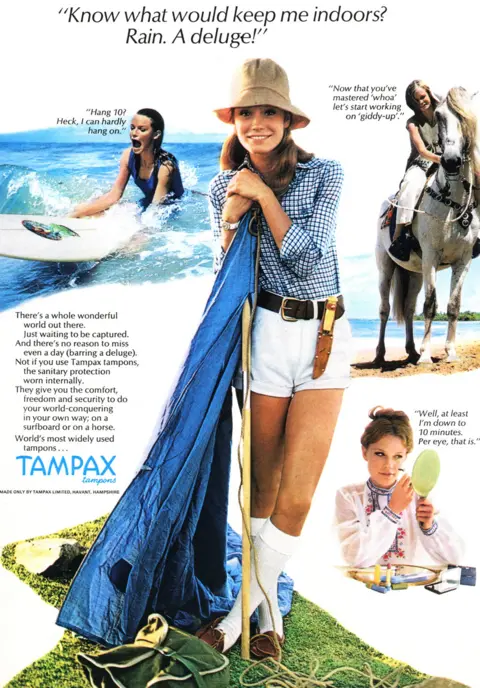 Alamy
AlamyBut in many parts of the world, it's no joke.
Consider the case of Arunachalam Muruganantham, a school dropout from southern India who, in 1998, decided his wife deserved hygienic, affordable pads rather than the dirty cloth she was having to use.
"I would not even use it to clean my scooter," he said.
He began experiments to produce a simple pad-making machine - something that could bring both jobs and cheap pads to women across India.
 Getty Images
Getty ImagesHis wife, Shanthi, walked out on him. So did his widowed mother. What he was doing was simply too humiliating.
Mr Muruganantham is now celebrated for his invention - and, yes, Shanthi did come back. But his setbacks give a sense of just how powerful the stigma remains in many parts of the world.
That stigma is one reason why - according to the United Nations Educational, Scientific and Cultural Organization (Unesco) - one in 10 girls in sub-Saharan Africa misses school during their periods. Dr Edward Clark might have approved but this is a serious matter: after falling behind, some girls drop out entirely.
It's not just the stigma - there's also a lack of access to clean water and lockable washrooms.
And, of course, there's the problem Mr Muruganantham was trying to solve: many young women simply can't afford the menstrual products others take for granted.
William Faulkner may have felt alienated by the Kotex age - but nearly a century later, many women are still waiting for that age to arrive.
The author writes the Financial Times's Undercover Economist column. 50 Things That Made the Modern Economy is broadcast on the BBC World Service. You can find more information about the programme's sources and listen to all the episodes online or subscribe to the programme podcast.
